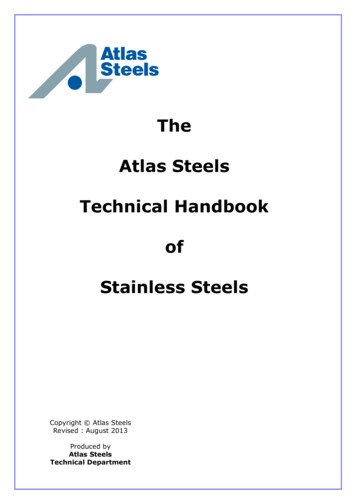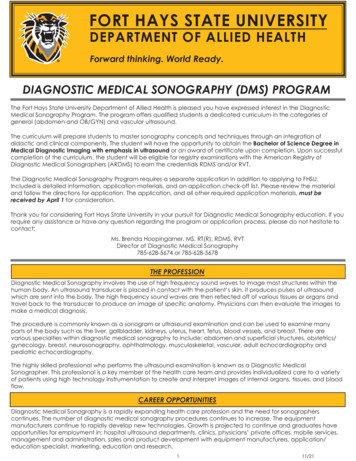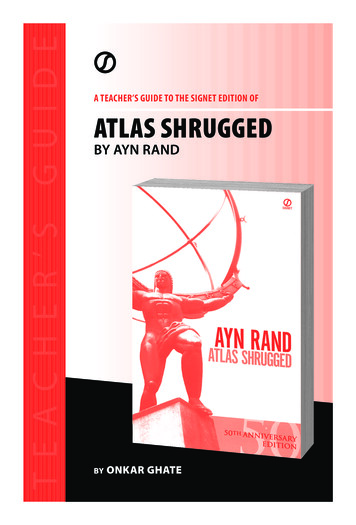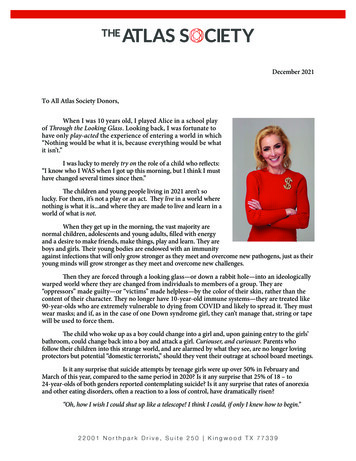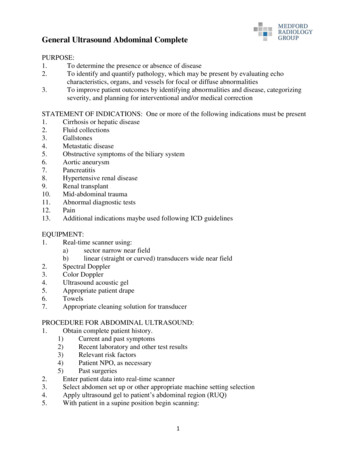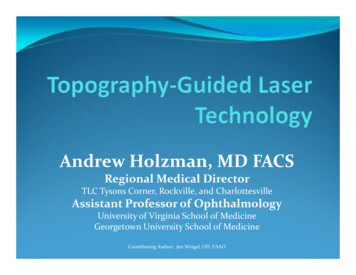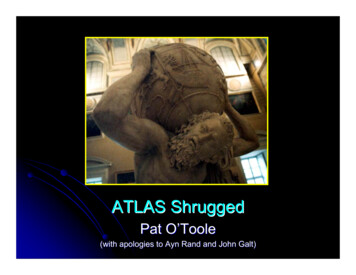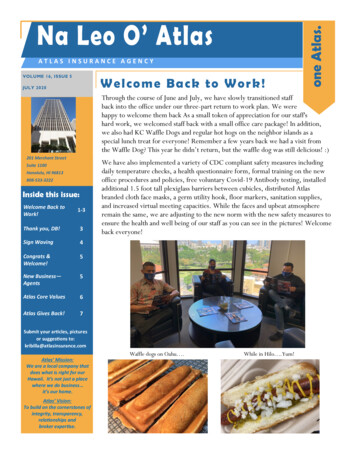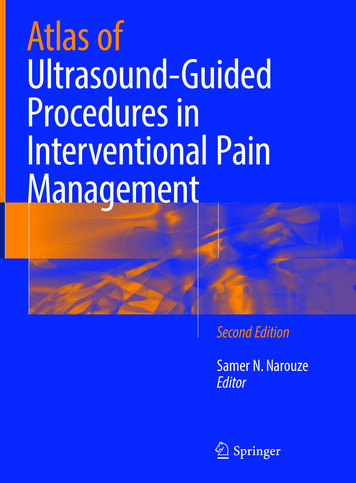
Transcription
Atlas ofUltrasound-GuidedProcedures inInterventional PainManagementSecond EditionSamer N. NarouzeEditor123
Atlas of Ultrasound-Guided Proceduresin Interventional Pain Management
Samer N. NarouzeEditorAtlas of Ultrasound-GuidedProcedures in InterventionalPain ManagementSecond Edition
EditorSamer N. NarouzeProfessor of Anesthesiology and Pain MedicineCenter for Pain MedicineWestern Reserve HospitalCuyahoga Falls, OH, USAISBN 978-1-4939-7752-9 ISBN 9-7754-3(eBook)Library of Congress Control Number: 2018941488 Springer Science Business Media, LLC, part of Springer Nature 2011, 2018This work is subject to copyright. All rights are reserved by the Publisher, whether the whole or part of the material isconcerned, specifically the rights of translation, reprinting, reuse of illustrations, recitation, broadcasting, reproductionon microfilms or in any other physical way, and transmission or information storage and retrieval, electronic adaptation,computer software, or by similar or dissimilar methodology now known or hereafter developed.The use of general descriptive names, registered names, trademarks, service marks, etc. in this publication does notimply, even in the absence of a specific statement, that such names are exempt from the relevant protective laws andregulations and therefore free for general use.The publisher, the authors and the editors are safe to assume that the advice and information in this book are believedto be true and accurate at the date of publication. Neither the publisher nor the authors or the editors give a warranty,express or implied, with respect to the material contained herein or for any errors or omissions that may have beenmade. The publisher remains neutral with regard to jurisdictional claims in published maps and institutional affiliations.Printed on acid-free paperThis Springer imprint is published by the registered company Springer Science Business Media, LLC part of SpringerNature.The registered company address is: 233 Spring Street, New York, NY 10013, U.S.A.
To my wife, Mira, and my children, John, Michael, and Emma – the true loveand joy of my life. Without their continued understanding and support,I could not have completed this book.This book is dedicated to the memory of my father who always had faithin me and to my mother for her ongoing love and guidance.
ForewordFor much of the past decade, fluoroscopy held sway as the favorite imaging tool of manypractitioners performing interventional pain procedures. Quite recently, ultrasound has emerged as a “challenger” to this well-established modality. The growing popularity of ultrasound application in regional anesthesia and pain medicine reflects a shift in contemporaryviews about imaging for nerve localization and target-specific injections. For regional anesthesia, ultrasound has already made a marked impact by transforming antiquated clinical practiceinto a modern science. No bedside tool ever before has allowed practitioners to visualize needle advancement in real time and observe local anesthetic spread around nerve structures. Forinterventional pain procedures, I believe this radiation-free, point-of-care technology will alsofind its unique role and utility in pain medicine and can complement some of the imagingdemands not met by fluoroscopy, computed tomography, and magnetic resonance imaging.And over time, practitioners will discover new benefits of this technology, especially fordynamic assessment of musculoskeletal pain conditions and improving accuracy of needleinjection for small nerves, soft tissue, tendons, and joints.Ultrasound application for pain medicine is an evolving subspecialty area. Most conventional pain interventionists skilled in fluoroscopy will find it necessary to undertake somespecial learning and training to acquire a new set of cognitive and technical skills before theycan optimally integrate ultrasound into their clinical practices. Although continuing medicaleducational events help facilitate the learning process and skill development, they are oftenlimited in breadth, depth, and training duration. This is why the arrival of this comprehensivetext, Atlas of Ultrasound-Guided Procedures in Interventional Pain Management, is so timelyand welcome. To my knowledge, this is the first illustrative atlas of its kind that addresses theeducational void for ultrasound-guided pain interventions.Preparation of this atlas, containing 6 parts and 30 chapters and involving more than 30authors, is indeed a huge undertaking. The broad range of ultrasound topics selected in thisbook provides a good, solid educational foundation and curriculum for pain practitioners bothin practice and in training. Included is the current state of knowledge relating to the basic principles of ultrasound imaging and knobology, regional anatomy specific to interventional procedures, ultrasound scanning and image interpretation, and the technical considerations forneedle insertion and injection. The ultrasound-guided techniques are described step-by-step inan easy-to-follow, “how to do it” manner for both acute and chronic pain interventions. Themajor topics include somatic and sympathetic neural blockade in the head and neck, limbs,spine, abdomen, and pelvis. Using a large library of black-and-white images and colored illustrative artwork, the authors elegantly impart scientific knowledge through the display of anatomic cadaveric dissections, sonoanatomy correlates, and schematic diagrams showingessential techniques for needle insertion and injection. The information in the last two chaptersof this book is especially enlightening and unique and is not commonly found in other standardpain textbooks. One chapter describes how ultrasound can be applied as an extension of physical examination to aid pain physicians in the diagnosis of musculoskeletal pain conditions.With ultrasound as a screening tool, pain physicians now have new opportunities to becomevii
viiiboth a diagnostician and an interventionist. The last chapter discussing advanced ultrasoundtechniques for cervicogenic headache, stimulating lead placement, and cervical disk injectiongives readers a glimpse of future exciting applications.This book is a distinguished product carefully prepared by Dr. Samer Narouze, the editor,and his handpicked group of contributors from all over the world. The authors are all recognized opinion leaders in anesthesiology, pain medicine, anatomy, and radiology. I believe thisquick reference book containing useful practical information will become a standard resourcefor any practitioner who seeks to learn ultrasound-guided interventional pain procedures forrelief of acute, chronic noncancer, and cancer pain. I am sure the readers will find this atlascomprehensive, inspiring, practical, and easy to follow.Vincent W. S. Chan,Department of Anesthesia, University of TorontoToronto, ON, CanadaForeword
PrefaceOver the past decade, ultrasonography provided to be a valuable imaging modality in interventional pain practice. The interest in ultrasonography in pain medicine (USPM) hasbeen fast growing, as evidenced by the plethora of published papers in peer-reviewed journalsas well as presentations at major national and international meetings. This has prompted thecreation of a special interest group on USPM within the American Society of RegionalAnesthesiology and Pain Medicine, of which I am honored to be the chair.The major advantages of ultrasonography (US) over fluoroscopy include the absence ofradiation exposure for both patient and operator, and the real-time visualization of soft tissuestructures, such as nerves, muscles, tendons, and vessels. The latter is why US guidance of softtissue and joint injections brings great precision to the procedure and why ultrasound-guidedpain nerve blocks improve its safety. That said, USPM is not without flaws. Its major shortcomings are the limited resolution at deep levels, especially in obese patients, and the artifactscreated by bone structures.While the evidence points to the superiority of US over fluoroscopy in peripheral nerves,soft tissue, and joint injections, it also suggests that we should not abandon fluoroscopy infavor of US in spine injections and should instead consider combining both imaging modalitiesto further enhance the goal of a successful and safer spine injection.When I first started using US in pain blocks in 2005, there was no single text on the subject,and that remains true up until the first edition of this atlas in 2011. Most of my knowledge onthe subject was gained from traveling overseas to learn from expert sonographers, radiologists,and anatomists. The rest was worked out by trial and error using dissected cadavers and confirming appropriate needle placement with fluoroscopy or CT scan. When I started teachingcourses on USPM, the overwhelmingly enthusiastic response from students persuaded me ofthe need for a comprehensive and easy-to-follow atlas of US-guided pain blocks. That is howthe first edition of this book – the first to cover this exciting new field – was born.Recent research evaluating ultrasonography in interventional pain procedures, the development of new technique and applications, and the establishment of neurosonology necessitates this version of the atlas with many updated and new chapters as well as a new sectionon diagnostic neurosonologyNot surprisingly, an extensive learning curve is associated withUS-guided pain blocks and spine injections. The main objective of this atlas is to enablephysicians managing acute and chronic pain syndromes who are beginning to use US-guidedpain procedures to shorten their learning curve and to make their learning experience as enjoyable as possible. Among the target groups are pain physicians, anesthesiologists, physiatrists,rheumatologists, neurologists, orthopedists, sports medicine physicians, spine specialists, andinterventional radiologists.I was fortunate to gather almost all of the international experts in US-guided pain blocks tocontribute to this second edition of the book, each one writing about his or her area of subspecialty expertise, and for this reason, I am very proud of the book. Its central focus is on anatomy and sonoanatomy. The clinical section begins with a chapter devoted to anatomy andsonoanatomy of the spine written by my dear friend, Professor Dr. Moriggl, who is a world- class anatomist from Innsbruck, Austria, with special expertise in sonoanatomy. He is the onlyone who could have written such a chapter. Each clinical chapter follows this format: d escriptionix
xPrefaceof sonoanatomy accompanied by illustrations; detailed description of how to perform the procedure, beginning with the choice and application of the transducer, to how the needle isintroduced, and finally, to how to confirm appropriate needle placement. This stepwise description of the technique is enhanced by sonograms both without labels and – to better understandthe images – with labels.The book comprises 34 chapters, organized into 7 parts, covering US-guided pain blocks inthe acute perioperative and chronic pain clinic settings, US-guided MSK applications, as wellas diagnostic neurosonology.Part I reviews the imaging modalities available to perform pain procedures and the basicsof ultrasound imaging. Two important clinical chapters cover the essential knobology of theultrasound machine and how to improve needle visibility under US.Part II is the largest and covers the sonoanatomy of the entire spine and spine injectiontechniques in the cervical, thoracic, lumbar, and sacral areas. All the different applications arewell documented with simple illustrations and labeled sonograms to make it easy to followthe text.Part III focuses on abdominal and pelvic blocks. It covers the now-famous transversusabdominis plane (TAP) block, celiac plexus block, and various pelvic and perineal blocks.Part IV addresses peripheral nerve blocks and catheters in the acute perioperative period aswell as peripheral applications in chronic pain medicine. Ultrasound-guided stellate and cervical sympathetic ganglion blocks are presented, as are peripheral nerve blocks commonly performed in chronic pain patients (e.g., intercostals, suprascapular, ilioinguinal, iliohypogastric,and pudendal). There is a new chapter on ultrasound-guided occipital nerve block.Part V discusses the most common joint and bursa injections and MSK applications in painpractice. The chapters are written by world experts in the area of MSK ultrasound.Part VI is anew section on diagnostic neurosonology. This section discusses the new application of ultrasound as a diagnostic tool in the diagnosis of different peripheral nerve entrapment syndromes.There is also a chapter devoted to occipital nerve entrapment.Part VII covers advanced andnew applications of ultrasound in neuromodulation and pain medicine and looks ahead to itsfuture. Ultrasound-guided peripheral nerve stimulation, occipital stimulation, and groin stimulation are presented as innovative applications of US in the cervical spine area, namely, atlanto- axial joint injection and cervical discography. Given the multitude of vessels and other vitalsoft tissue structures compacted in a limited area, ultrasonography seems particularly relevantin the cervical area.A couple of notes about the book: the text has been kept to a minimum to allow for amaximal number of instructive illustrations and sonograms, and the procedures described hereare based on a review of the techniques described in the literature as well as the authors’experience.The advancement of ultrasound technology and the range of possible clinical circumstancesmay give rise to other, more appropriate approaches in USPM. Until then, mastering the current approaches will take preparation, practice, and appropriate mentoring before the physiciancan comfortably perform the procedures independently. It is my hope that this book willencourage and stimulate all physicians interested in interventional pain management.Akron, OH, USA Samer N. Narouze
AcknowledgmentsIn preparing Atlas of Ultrasound-Guided Procedures in Interventional Pain Management, Ihad the privilege of gathering highly respected international experts in the field of ultrasonography in pain medicine. I thank Dr. Chan, professor of Anesthesiology at the University ofToronto and past president of the American Society of Regional Anesthesiology and PainMedicine (ASRA), for agreeing to contribute a chapter to this book. I also extend my sincerethanks to the founding members of the ASRA special interest group on ultrasonography in painmedicine, who are also my friends and colleagues, for contributing essential chapters in theirareas of expertise: Dr. Eichenberger (Switzerland), Dr. Gofeld (Canada), Dr. Morrigl (Austria),Dr. Peng (Canada), and Dr. Shankar (Wisconsin).My sincere thanks to Dr. Galiano and Dr. Gruber of Austria for contributing two chapters tothe book – and for introducing me to ultrasound-guided pain blocks when I visited their clinicin Innsbruck in 2005. I also acknowledge my esteemed colleagues from the University ofToronto for their help and support: Dr. McCartney, Dr. Brull, Dr. Perlas, Dr. Awad, Dr. Bhatia,and Dr. Riazi.I cannot thank enough my friends Dr. Huntoon (Mayo Clinic) and Dr. Karmakar (HongKong) for agreeing to contribute essential chapters despite their busy schedules. A specialthank you to Dr. Ilfeld (UCSD) and Dr. Mariano (Stanford) for their help with the regionalanesthesia section; Dr. Bodor (UCSF), Dr. Hurdle (Mayo Clinic), and Dr. Schaefer (CWRU)for their help with the musculoskeletal (MSK) section; and Dr. Samet (Northwestern University)for contributing the diagnostic neurosonology chapter.I express my sincere thanks to all the Springer editorial staff for their expertise and help inediting this book and making it come to life on time.I am very blessed that these experts agreed to contribute to my book, and I am very gratefulto everyone.xi
ContentsPart I Imaging in Interventional Pain Management and Basics of Ultrasonography1 Imaging in Interventional Pain Management 3Marc A. Huntoon2 Basics of Ultrasound: Pitfalls and Limitations 11Vincent Chan and Anahi Perlas3 Essential Knobology for Ultrasound- Guided Regional Anesthesiaand Interventional Pain Management 17Alan J. R. Macfarlane, Cyrus C. H. Tse, and Richard Brull4 Ultrasound Technical Aspects: How to Improve Needle Visibility 27Dmitri Souza, Imanuel Lerman, and Thomas M. HalaszynskiPart II Spine Sonoanatomy and Ultrasound-Guided Spine Injections5 Spine Sonoanatomy for Pain Physicians 59Bernhard Moriggl6 Ultrasound-Guided Third Occipital Nerve and Cervical MedialBranch Nerve Blocks 83Andreas Siegenthaler and Urs Eichenberger7 Ultrasound-Guided Cervical Zygapophyseal (Facet)Intra-Articular Injection 91Samer N. Narouze8 Ultrasound-Guided Cervical Nerve Root Block 95Samer N. Narouze9 Ultrasound-Guided Thoracic Paravertebral Block 103Manoj Kumar Karmakar10 Ultrasound-Guided Lumbar Facet Nerve Block and Intra-articularinjection 117David M. Irwin and Michael Gofeld11 Ultrasound-Guided Lumbar Nerve Root (Periradicular) Injections 125Klaus Galiano and Hannes Gruber12 Ultrasound-Guided Central Neuraxial Blocks 129Manoj Kumar Karmakar13 Ultrasound-Guided Caudal Epidural Injections 145Amaresh Vydyanathan and Samer N. Narouzexiii
xiv14 Ultrasound-Guided Sacroiliac Joint Injection 151Amaresh Vydyanathan and Samer N. NarouzePart III Ultrasound-Guided Abdominal and Pelvic Blocks15 Ultrasound-Guided Transversus Abdominis Plane (TAP) Block 157Samer N. Narouze and Maged Guirguis16 Ultrasound-Guided Celiac Plexus Block and Neurolysis 161Samer N. Narouze and Hannes Gruber17 Ultrasound-Guided Blocks for Pelvic Pain 167Chin-Wern Chan and Philip W. H. Peng18 Ultrasound-Guided Ganglion Impar Injection 181Amaresh Vydyanathan and Samer N. NarouzePart IV Ultrasound-Guided Peripheral Nerve Blocks and Catheters19 Ultrasound-Guided Upper Extremity Blocks 185Jason McVicar, Sheila Riazi, and Anahi Perlas20 Ultrasound-Guided Nerve Blocks of the Lower Limb 201Mandeep Singh, Imad T. Awad, and Colin J. L. McCartney21 Ultrasound-Guided Continuous Peripheral Nerve Blocks 217Edward R. Mariano and Brian M. Ilfeld22 Ultrasound-Guided Superficial Trigeminal Nerve Blocks 227David A. Spinner and Jonathan S. Kirschner23 Ultrasound-Guided Greater Occipital Nerve Block 231Bernhard Moriggl and Manfred Greher24 Ultrasound-Guided Cervical Sympathetic Block 237Philip W. H. Peng25 Ultrasound-Guided Peripheral Nerve Blockade in ChronicPain Management 243Anuj Bhatia and Philip W. H. PengPart V Diagnostic and Musculoskeletal (MSK) Ultrasound26 Ultrasound-Guided Shoulder Joint and Bursa Injections 255Michael P. Schaefer and Kermit Fox27 Ultrasound-Guided Hand, Wrist, and Elbow Injections 267Marko Bodor, John M. Lesher, and Sean Colio28 Ultrasound-Guided Intra-articular Hip Injections 279Hariharan Shankar and Kashif Saeed29 Ultrasound-Guided Knee Injections 283Mark-Friedrich B. HurdlePart VI Diagnostic Neurosonology30 Ultrasonography of Peripheral Nerves 289Swati Deshmukh and Jonathan SametContents
Contentsxv31 Occipital Neuralgia: Sonoanatomy and Sonopathologyof the Occipital Nerves 297Samer N. NarouzePart VII Advanced and New Applications of Ultrasound32 Ultrasound-Guided Atlanto-Axial and Atlanto-Occipital Joint Injections 307Samer N. Narouze33 Ultrasound-Guided Peripheral Nerve Stimulation 311Marc A. Huntoon34 Ultrasound-Guided Occipital Stimulation 317Samer N. Narouze35 Ultrasound-Guided Groin Stimulation 321Samer N. Narouze36 Ultrasound-Assisted Cervical Diskography and Intradiskal Procedures 323Samer N. Narouze Index 327
ContributorsImad T. Awad, MBChB, FCA, RSCI Department of Anesthesia, Sunnybrook HealthSciences Center, University of Toronto, Toronto, ON, CanadaAnuj Bhatia, MBBS, FIPP, EDRA, MD Department of Anesthesia and Pain Management,University of Toronto, Toronto Western Hospital, Toronto, ON, CanadaMarko Bodor, MD Department of Neurological Surgery, University of California SanFrancisco, Department of Physical Medicine and Rehabilitation, University of CaliforniaDavis, Bodor Clinic, Napa, CA, USARichard Brull,MD, FRCPC Department of Anesthesia, University of Toronto,Toronto Western Hospital, Toronto, ON, CanadaChin-Wern Chan, MBBS, BMedSci, FANZCA Wasser Pain Management Center andDepartment of Anesthesia, University Health Network and Mount Sinai Hospital,Toronto, ON, CanadaVincent Chan, MD Department of Anesthesia, University of Toronto, Toronto WesternHospital, Toronto, ON, CanadaSean Colio, MD Department of Orthopedic Surgery, Stanford University, Los Gatos,CA, USASwati Deshmukh, MD Departments of Musculoskeletal Imagine and Radiology,Northwestern Medical Group, Chicago, IL, USAUrs Eichenberger, MD Department of Anesthesiology and Pain Therapy, University Hospitalof Bern, Inselspital, Bern, SwitzerlandKermit Fox, MD Department of Outpatient/Ambulatory Medicine, Case Western ReserveUniversity, MetroHealth Rehabilitation Institute, Cleveland, OH, USAKlaus Galiano, MD, PhD Department of Neurosurgery, Innsbruck Medical University,Innsbruck, AustriaMichael Gofeld, MD, PhD Department of Anesthesia, University of Toronto, Toronto, ON,CanadaManfred Greher, MD, PhD Department of Anesthesiology, Perioperative Intensive Care,and Pain Therapy, Hrez-Jesu Hospital, Vienna, AustriaHannes Gruber Department of Radiology, Innsbruck Medical University, Innsbruck, AustriaMaged Guirguis, MD Department of Anesthesia and Pain Management, Ochsner HealthSystem, New Orleans, LA, USAThomas M. Halaszynski, DMD, MD, MBA Department of Anesthesiology, Yale UniversitySchool of Medicine, New Haven, CT, USAxvii
xviiiMarc A. Huntoon, MD Department of Pain Management, VCU Neuroscience Orthopedicand Wellness Center (NOW), Virginia Commonwealth University, Nashville, TN, USAMark-Friedrich B. Hurdle, MD Department of Anesthesiology and Pain Medicine,Mayo Clinic, Jacksonville, FL, USABrian M. Ilfeld, MD, MS (Clinical Research) Department of Anesthesiology,University California San Diego, San Diego, CA, USADavid M. Irwin, MD Department of Anesthesia, University of Toronto, Toronto, ON, CanadaManoj Kumar Karmakar, MD, FRCA, Department of Anaesthesia and Intensive Care, TheChinese University of Hong Kong, Prince of Wales Hospital, Shatin,New Territories, Hong KongJonathan S. Kirschner, MD, RMSK Physiatry, Hospital for Special Surgery, Weill CornellMedicine, New York, NY, USAImanuel Lerman, MD, MS Department of Anesthesiology, University of California,San Diego, La Jolla, CA, USAJohn M. Lesher, MD, MPH Carolina Neurosurgery and Spine Associates, Huntersville,NC, USAAlan J. R. Macfarlane Department of Anaesthesia, Glasgow Royal Infirmary, Glasgow, UKEdward R. Mariano, MD VA Palo Alto Health Care System, Anesthesiology and PerioperativeCare Service, Palo Alto, CA, USAColin J. L. McCartney, BSc(Hons), MBChB, MRCP, FRCA, EDRA The Ottawa Hospital,Civic Campus, Ottawa, ON, CanadaJason McVicar, MD Department of Anesthesia, University of Toronto, Toronto WesternHospital, Toronto, ON, CanadaBernhard Moriggl, MD Department of Anatomy, Histology, and Embryology, Division ofClinical and Functional Anatomy, Medical University of Innsbruck (MUI), Innsbruck, AustriaSamer N. Narouze, MD, PhD Professor of Anesthesiology and Pain Medicine, Center forPain Medicine, Western Reserve Hospital, Cuyahoga Falls, OH, USAPhilip W. H. Peng, MBBS, FRCPC, Founder(Pain Medicine) Department of Anesthesiaand Pain Management, University of Toronto, Toronto Western Hospital, Toronto, ON, CanadaAnahi Perlas Department of Anesthesia, University of Toronto, Toronto Western Hospital,Toronto, ON, CanadaSheila Riazi, MD, FRCPC Department of Anesthesia, University of Toronto, TorontoWestern Hospital, Toronto, ON, CanadaKashif Saeed, MD Medical College of Wisconsin, Clement Zablocki VA Medical Center,Milwaukee, WI, USAJonathan Samet, MD Department of Radiology, Northwestern Memorial Hospital,Ann and Robert H. Lurie Children’s Hospital of Chicago, Chicago, IL, USAMichael P. Schaefer, MD Case Western Reserve University, Metro Health RehabilitationInstitute of Ohio, Cleveland, OH, USAHariharan Shankar, MD Medical College of Wisconsin, Clement Zablocki VA MedicalCenter, Milwaukee, WI, USAAndreas Siegenthaler, MD Department of Anesthesiology and Pain Therapy, LindenhofHospital, Bern, SwitzerlandContributors
ContributorsxixMandeep Singh, MBBS, MD, MSc, FRCPC Department of Anesthesia, Toronto WesternHospital, University of Toronto, Toronto, ON, CanadaDmitri Souza, MD, PhD Director of Clinical Research, Center for Pain Medicine, ClinicalProfessor of Anesthesiology, Ohio University, Heritage College of Osteopathic Medicine,Cuyahoga Falls, Ohio, USADavid A. Spinner, DO, RMSK Department of Rehabilitation Medicine, Mount SinaiHospital, New York, NY, USACyrus C. H. Tse, BSc Department of Anesthesia, Toronto Western Hospital, Toronto,ON, CanadaAmaresh Vydyanathan, MBBS, MS Department of Anesthesiology, Department ofRehabilitation Medicine, Albert Einstein College of Medicine, Montefiore MultidisciplinaryPain Program, Bronx, NY, USA
Part IImaging in Interventional Pain Management andBasics of Ultrasonography
1Imaging in Interventional PainManagementMarc A. Huntoon IntroductionInterventional pain procedures are commonly performed eitherwith image-guidance fluoroscopy, computed tomography (CT),or ultrasound (US) or without image guidance utilizing surfacelandmarks. Recently, three-dimensional rotational angiography(3D-RA) suites also known as flat detector computed tomography (FDCT) or cone beam CT (CBCT) and digital subtractionangiography (DSA) have been introduced as imaging adjuncts.These systems are indicative of a trend toward increased use ofspecialized visualization techniques. Pain medicine practiceguidelines suggest that most procedures require image guidanceto improve the accuracy, reproducibility (precision), safety, anddiagnostic information derived from the procedure [1].Historically, pain medicine practitioners were slow adopters ofimage-guidance techniques, largely because the most commonparent specialty (anesthesiology) had a culture of using surfacelandmarks to aid the perioperative performance of various nerveblocks and vascular line placements [2]. Indeed, some painmedicine practitioners in the 1980s and early 1990s felt thatstudies advocating the inaccuracy of epidural steroid injectionsperformed with surface landmarks [3] were published more forspecialty access than to increase patient safety or improveoutcomes.Ultrasound has recently exploded in popularity for perioperative regional blockade, but utilization of other imagingmodalities in the perioperative arena, e.g., fluoroscopy, haslagged behind, despite more accurate placements comparedto surface landmark-driven placements [2]. Technologyacquisition costs and the physician learning required to master the new technologies are significant barriers to full implementation of many advanced imaging systems. However, theM. A. Huntoon (*)Department of Pain Management, VCU Neuroscience Orthopedicand Wellness Center (NOW), Virginia Commonwealth University,Nashville, TN, USAe-mail: Huntoon.Marc@mayo.eduincreasing national focus on safety in clinical medicine mayultimately mandate the use of optimal image guidance forselected procedures. In most cases, studies are lacking tocompare the various types of image guidance in terms ofpatient outcomes, safety, and cost value for specific procedures. This is further complicated by the fact that many procedures in pain medicine have been considered poorlyvalidated for the conditions being treated [4–6]. Thus, it maynot matter if a particular image-guidance technique improvesthe reliability of a given pr
and pudendal). There is a new chapter on ultrasound-guided occipital nerve block. Part V discusses the most common joint and bursa injections and MSK applications in pain practice. The chapters are written by world experts in the area of MSK ultrasound
